FamilySearch Celebrates 125th Anniversary
Contributed By Sydney Walker, Church News staff writer
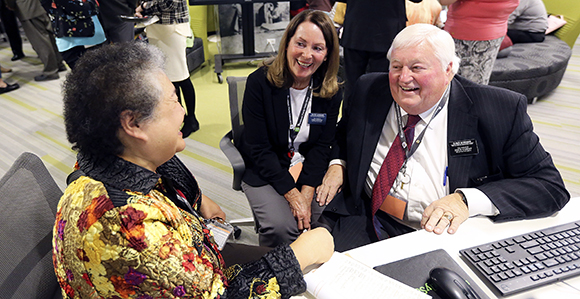
Sister Rosemary Pangan, Sister Diana Wiseman, and Elder Steve Wiseman chat during the FamilySearch 125th-anniversary celebration at the Family History Library in Salt Lake City on Wednesday, November 13, 2019. Photo by Kristin Murphy, Deseret News.
Article Highlights
- The anniversary epitomizes the growth of the organization and the increasing interest of people worldwide to know more about their roots.
- The focus of FamilySearch today is to make the records of humanity available to all of God’s family, not just Church members.
- All of FamilySearch’s efforts ultimately lead to the temple, where families can be sealed together forever.
“We have the great blessing now . . . to move forward to build this department, to build this technology, to build this database, to build this family tree of God’s human family.” —Elder Kevin S. Hamilton, executive director of the Family History Department
Related Links
In an upstairs room of the Church Historian’s Office in Salt Lake City on November 13, 1894, the Genealogical Society of Utah was established under the direction of Wilford Woodruff, the fourth President of The Church of Jesus Christ of Latter-day Saints.
Today, the Genealogical Society of Utah is known as FamilySearch International, and it stands as the largest genealogy organization in the world. Over the past 125 years, FamilySearch has worked to publish almost 4.8 billion searchable records and grow its family tree to more than 1.2 billion people.
“From a small, humble beginning in an upstairs room with 190 donated books 125 years ago, we today are moving forward at an ever accelerating pace,” said Elder Kevin S. Hamilton, executive director of the Family History Department, during an anniversary celebration on Wednesday, November 13.
Former and current Family History Department executive directors, assistant executive directors, managing directors, employees, missionaries, and patrons gathered at the Family History Library in Salt Lake City to commemorate the 125th anniversary of the Genealogical Society of Utah—a milestone that epitomizes not only the growth of the organization but also the increasing interest of people worldwide to know more about their roots.
Elder Hamilton quoted President Russell M. Nelson at the Rome Italy Temple dedication, when he said, “This is a hinge point in the history of the Church. Things are going to move forward at an accelerated pace. . . . The Church is going to have an unprecedented future, unparalleled. We’re just building up to what’s ahead now.”
As evidence of the work moving forward, Elder Hamilton cited RootsTech London in October, which he described as “above and beyond our wildest expectations for a first-ever event in a foreign country.”
“The Lord is in the details. He has His hand in this work. We are engaged in His work as His family, and we are His children. We are simply the stewards, the caretakers, of this process of the present time,” Elder Hamilton said.
“We are blessed to have been able to stand on the shoulders of the great ones, those that have the vision, those that brought this to the point where we’re at today. And we have the great blessing now to stand on their shoulders and to move forward to build this department, to build this technology, to build this database, to build this family tree of God’s human family.”
The Beginning
In an interview with the Church News a week before the anniversary celebration, David Rencher, director of the Family History Library and chief genealogical officer of FamilySearch, commented on some of the historical background of the Genealogical Society of Utah.
One point is the connection to the Salt Lake Temple. About 18 months prior to the establishment of the Genealogical Society of Utah, President Woodruff dedicated the Salt Lake Temple on April 6, 1893. In the dedicatory prayer, President Woodruff asked the Lord to send the spirit of Elijah and increase the desire of the Saints to search out their ancestors.
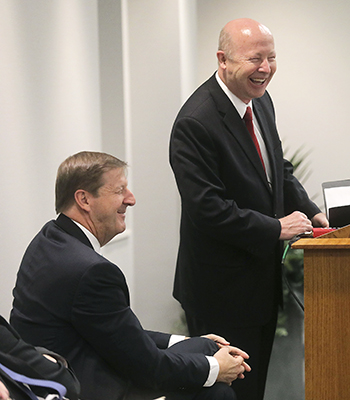
Steve Rockwood, FamilySearch CEO, left, and Richard E. Turley, right, former managing director of the Family History Department, laugh during the FamilySearch 125th-anniversary celebration at the Family History Library in Salt Lake City on Wednesday, November 13, 2019. Photo by Kristin Murphy, Deseret News.
“Bless them, we pray Thee, in their labors, that they may not fall into errors in preparing their genealogies,” President Woodruff prayed. “Furthermore, we ask Thee to open before them new avenues of information, and place in their hands the records of the past, that their work may not only be correct but complete also.”
Rencher said the answer to this prayer was “very real and very dramatic” with the publication of family histories.
“Over the next two decades after that prayer, there was a flurry of published family histories produced, particularly in New England, where many of the Saints had originated,” Rencher said. “And these published family histories yielded thousands of names of ancestors and family members of the Saints who are here in the valley.”
There were other factors that contributed to the establishment of a genealogical organization. At the time the Salt Lake Temple was dedicated, sealing ordinances were limited. In addition to husbands and wives being sealed to each other and men and women being sealed by proxy to their deceased parents, it was a custom to be “adopted” into the family of a Church leader or other prominent priesthood holder.
In the April 1894 general conference, President Woodruff announced a change in policy: “Let every man be adopted to his father[,] . . . not to any other man outside the lineage of his father.”
President Woodruff continued: “We want the Latter-day Saints from this time to trace their genealogies as far as they can, and to be sealed to their fathers and mothers. Have children sealed to their parents, and run this chain through as far as you can get it” (in James B. Allen and others, “Hearts Turned to the Fathers: A History of the Genealogical Society of Utah, 1894–1994,” BYU Studies, vol. 34, no. 2 [Jan. 1, 1995]).
The new policy had a large impact on genealogical work as Latter-day Saints committed more fully to finding and organizing correct family records.
With the approval of the First Presidency and Quorum of the Twelve Apostles, the Genealogical Society of Utah was established in 1894. Franklin D. Richards was the first president of the organization.
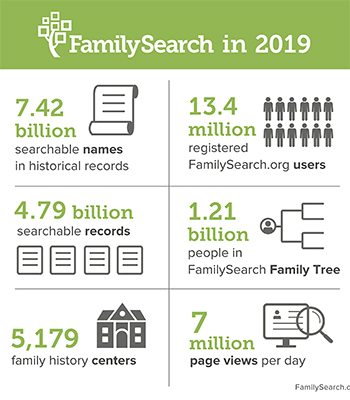
An overview of FamilySearch since it was established 125 years ago as the Genealogical Society of Utah. Graphic courtesy of FamilySearch.org.
The organization began building its library with 190 volumes donated by Franklin D. Richards. He had been gathering the books out of his own interest for several years, explained Elder Kent F. Richards, emeritus General Authority Seventy and the great-great-grandson of Franklin D. Richards, during the anniversary celebration.
The goals of the organization were, first, to establish and maintain a genealogical library for the use and benefit of anyone who was interested; second, to disseminate genealogical information; and, third, to acquire records of the dead in order to perform ordinances on their behalf (see Allen and others, Hearts Turned to the Fathers).
Elder Hamilton said of living up to the original goals of the Genealogical Society of Utah, “I think those goals were inspired and today are still the same.
“We have a little different terminology we use, but that’s really our focus today, to try to make the records of humanity available to God’s family,” he said. “And we work very diligently to gather those records to make them available and help people find them.”
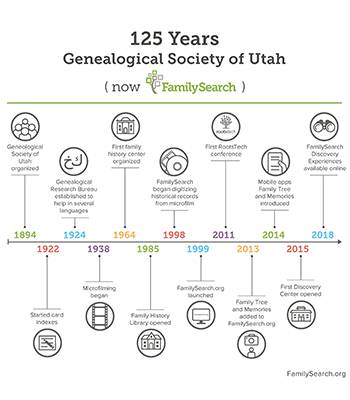
A historical time line of FamilySearch, formerly known as the Genealogical Society of Utah, since 1894. Graphic courtesy of FamilySearch.org.
Quoting the purpose statement of the Family History Department, Elder Hamilton said, “We create inspiring experiences that bring joy to all people, as they discover, gather, and connect their family, past, present, and future.
“Our Heavenly Father loves all of His children. All means all.”
Just as membership in the early days of the Genealogical Society was open to anyone who was interested, FamilySearch continues to serve and connect individuals all over the world, not just Church members.
Rapid Advancements
Many notable advancements over the next century allowed the Genealogical Society of Utah to expand, Rencher explained. Paper indexing began in 1922. In 1924, the Genealogical Research Bureau was established to help in several languages. The Temple Index Bureau was created in 1927 to coordinate efforts and prevent duplication.
Microfilming began in 1938. “Suddenly, that completely changed the landscape for us,” Rencher said. “Now, not only we didn’t have to depend on just what was published[;] . . . now we could actually start to look at images of original records.”
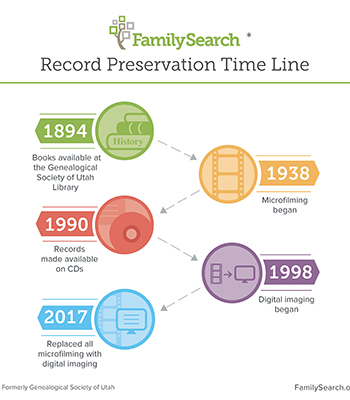
The history of FamilySearch’s records preservation efforts beginning in 1894. Graphic courtesy of FamilySearch.org.
In 1963, the Granite Mountain Records Vault was built to store microfilm. With the opening of the first branch libraries in 1964, now known as family history centers, those images could be disseminated. Today, more than 5,000 family history centers are found in 129 countries.
The Personal Ancestral File software was released in 1984, allowing patrons to record information on a personal computer.
“We went from microfiche to compact discs to computer programs to personal desktop organizations. We went through that whole succession of very rapid transition,” Rencher said.
As part of an effort to simplify ancestral research and encourage members to perform temple ordinances for their ancestors, the Genealogical Department of the Church was renamed to be the Family History Department in 1987.
President Boyd K. Packer, a member of the Quorum of the Twelve Apostles who died in 2015, was chairman of the Temple and Family History Executive Council when the name change occurred. He said, “The word genealogy often suggests a need for professional training, . . . and the change to ‘family history’ will make the work less technical and more appealing to members of the Church.
“A genealogy is, in fact, a family history,” President Packer continued, “and such sacred family history is fundamental to the temple ordinances and covenants that bless individuals and seal them into eternal families” (in “Family History Department Is New Name for Genealogical Department,” Ensign, Oct. 1987).
There was no change in the name of the Genealogical Society of Utah at that time, but a new and upcoming website would soon spark a name change to the organization.

The services FamilySearch offers have evolved since the organization’s establishment in 1894. Graphic courtesy of FamilySearch.org.
With the launch of a website, the Family History Department needed a “handle” that would be “definitive of our online presence,” Rencher said. In 1999, FamilySearch.org was launched. The Genealogical Society of Utah was later renamed in 2005 to “FamilySearch” to better fit the description of what the organization does and what it offers.
Rencher said it has been “an absolute wonder” to watch the progression of what has happened at FamilySearch in the almost 40 years since he began working there. And much of what was done throughout the 20th century is still part of today’s FamilySearch.
“I think it’s remarkable that we have been able to grow and progress with technology and take advantage of the new technologies as each one of them have come along, and in many ways, I think both perfect and expound upon them,” he said.
Elder Hamilton commented on the future of FamilySearch during the anniversary celebration. He mentioned the interest in computer-assisted indexing, machine learning, and artificial intelligence to speed up the indexing process. He also said FamilySearch is beginning to look at the potential of using computer-assisted tree building.
“We’re just beginning our strategy for DNA research and DNA utilization,” he added. “The technology is new, and we do not yet completely understand how this all works. But the potential is there for us to reconstruct the family tree of humankind using DNA.”
Elder Hamilton said FamilySearch will continue to strive to “engage, entice, and encourage” all of Heavenly Father’s children to participate in the work of salvation.
Commemorating the Milestone
Rencher said he hopes the 125th anniversary of FamilySearch prompts people to think about their families, what brings them together and connects them.
The real energy in family history is hearing the stories and learning how ancestors overcame obstacles in their lives, Rencher said. This helps people understand that “this is the family I come from, and this is what we’re made of.”
During the anniversary celebration on November 13, Steve Rockwood, CEO of FamilySearch International, shared an experience about the power of family stories.
When Rockwood woke up at 6:00 a.m. that day, he said he noticed a FamilySearch hint in his inbox. He was reminded that his great-great-grandfather William Hill died on this particular day, November 13, 1907—just years after the formation of the Genealogical Society of Utah.
“I thought, at this moment, still in my pajamas, I am the beneficiary of literally generations and generations of efforts to make that happen on my phone,” he said.
Rockwood noted the contributions of the “unheralded,” with no bylines, that helped him feel the spirit and power of family history that day as he turned his heart to William Hill—the person who operated the microfilm camera so he could view the record, the person who indexed the record, and the people behind the technology that sent the notification to his phone.
“This is the first day of a full year of recognition and appreciation for the unheralded. We’ve only just begun. And in the year 2020, we will indeed focus in on the rich, wonderful past so that we can continue into the exploding future,” he said.
To celebrate the genealogy discoveries over the past 125 years, FamilySearch has invited people to share their family history stories using the hashtag #FoundAtFamilySearch.
“What we’ve learned is that it all starts with stories,” Rockwood said. “We want to capture the stories of the employees and every single missionary and volunteer. Each has a story that brought them to personally participate. We want to capture that in a two-minute bite. What was it that brought them to discover the incredible spirit and emotion of family history?”
Opportunities to capture those stories can be found on FamilySearch.org, on the Family Tree mobile app, and in the family discovery centers.
Elder Hamilton closed the anniversary celebration by paraphrasing President Nelson: “Everything we do in the Church, every aspect of every program, every department, ultimately leads to the temple.”
He then added, “All that we do, all of our efforts, all of our work, all of our objectives, and all of our plans are to help bring the family of our Heavenly Father together in the holy, sacred temples that are being built across the earth, where we can then seal them together in one great family.”
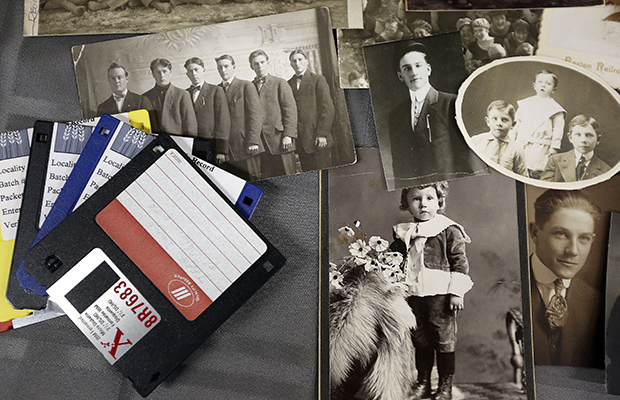
Display of historical photos and hard disks during the FamilySearch 125th-anniversary celebration at the Family History Library in Salt Lake City on Wednesday, November 13, 2019. Photo by Kristin Murphy, Deseret News.

From left: Richard E. Turley, former managing director of the Family History Department; Elder Richard Maynes, General Authority Seventy of The Church of Jesus Christ of Latter-day Saints; and Elder Kent F. Richards, emeritus General Authority Seventy of The Church of Jesus Christ of Latter-day Saints, chat during the FamilySearch 125th-anniversary celebration at the Family History Library in Salt Lake City on Wednesday, November 13, 2019. Photo by Kristin Murphy, Deseret News.
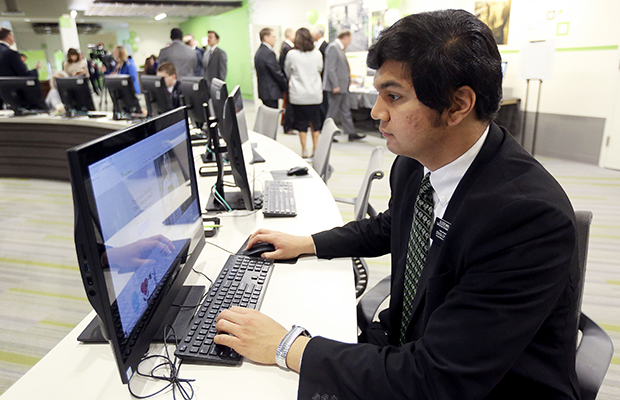
Elder Helaman Malolo does family history research during the FamilySearch 125th-anniversary celebration at the Family History Library in Salt Lake City on Wednesday, November 13, 2019. Photo by Kristin Murphy, Deseret News.
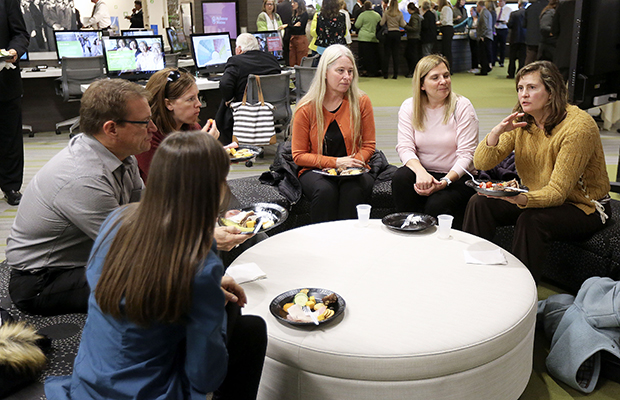
People chat and snack during the FamilySearch 125th-anniversary celebration at the Family History Library in Salt Lake City on Wednesday, November 13, 2019. Photo by Kristin Murphy, Deseret News.
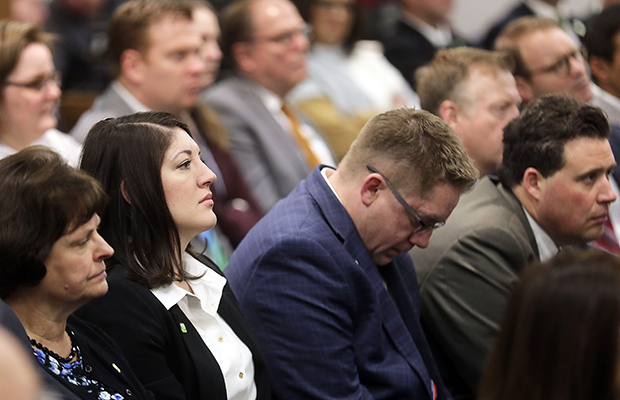
Selaina Broderick listens during the FamilySearch 125th-anniversary celebration at the Family History Library in Salt Lake City on Wednesday, November 13, 2019. Photo by Kristin Murphy, Deseret News.
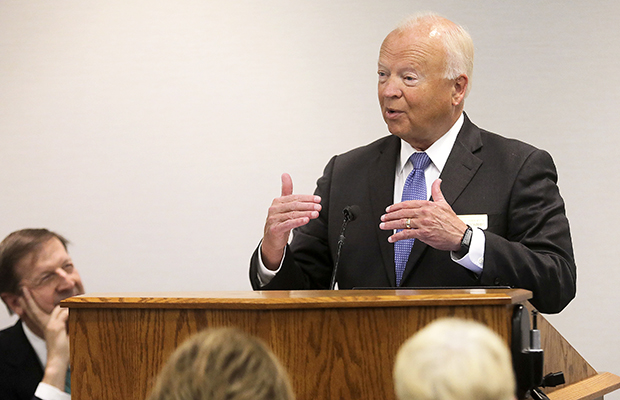
Elder Kent F. Richards, emeritus General Authority Seventy of The Church of Jesus Christ of Latter-day Saints, speaks during the FamilySearch 125th-anniversary celebration at the Family History Library in Salt Lake City on Wednesday, November 13, 2019. Photo by Kristin Murphy, Deseret News.
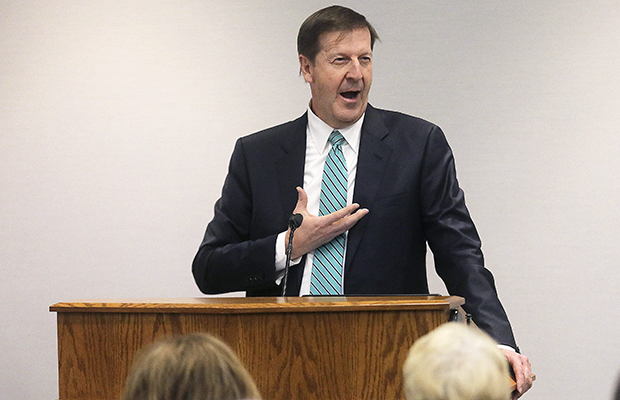
Steve Rockwood, FamilySearch International CEO, speaks during the FamilySearch 125th-anniversary celebration at the Family History Library in Salt Lake City on Wednesday, November 13, 2019. Photo by Kristin Murphy, Deseret News.
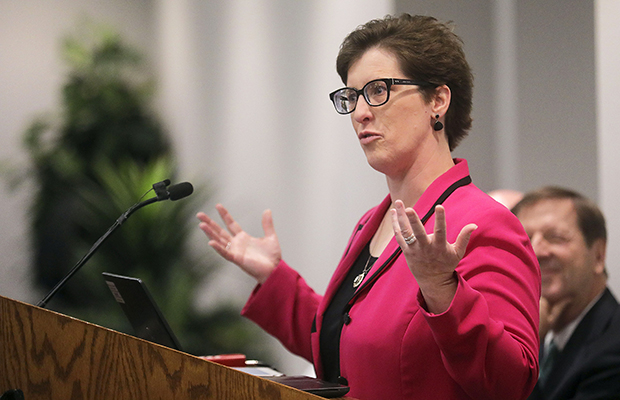
Diane Loosle, senior vice president of Patron Services and director of the Family History Library at FamilySearch, speaks during the FamilySearch 125th-anniversary celebration at the Family History Library in Salt Lake City on Wednesday, November 13, 2019. Photo by Kristin Murphy, Deseret News.
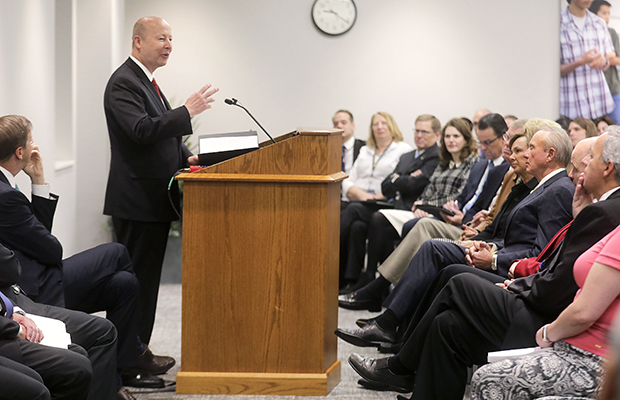
Richard E. Turley, former managing director of the Family History Department, speaks during the FamilySearch 125th-anniversary celebration at the Family History Library in Salt Lake City on Wednesday, November 13, 2019. Photo by Kristin Murphy, Deseret News.
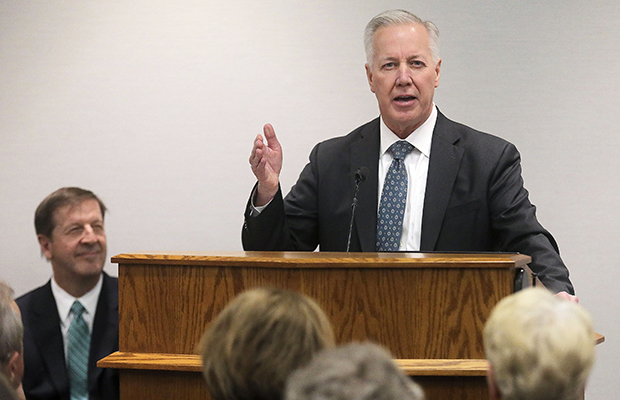
Elder Kevin S. Hamilton, executive director of the Family History Department and General Authority Seventy of The Church of Jesus Christ of Latter-day Saints, speaks during the FamilySearch 125th-anniversary celebration at the Family History Library in Salt Lake City on Wednesday, November 13, 2019. Photo by Kristin Murphy, Deseret News.

The Salt Lake City offices of FamilySearch, formerly known as the Genealogical Society of Utah, have changed over the past 125 years. Graphic courtesy of FamilySearch.org.
